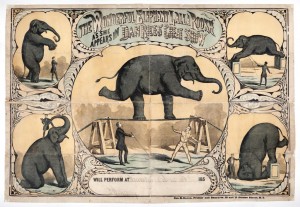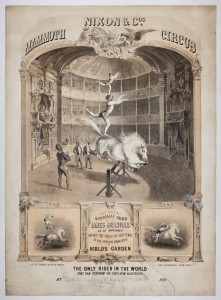 This month Circus and the City: New York, 1793-2010 opened at the Bard Graduate Center Galleries in New York (September 12, 2012 to February 3, 2013). You can learn more about the exhibition here. Two former AAS fellows, Matthew Wittmann and Brett Mizelle, contributed essays to the related (and very substantial) publication, The American Circus (New York: Bard Graduate Center, 2012), and the Society loaned four circus posters to the show, including one large poster of the elephant Lalla Rookh from the 1850s. Another of the AAS’s posters was featured in the New York Times review and slideshow of the exhibition, which you can read here.
This month Circus and the City: New York, 1793-2010 opened at the Bard Graduate Center Galleries in New York (September 12, 2012 to February 3, 2013). You can learn more about the exhibition here. Two former AAS fellows, Matthew Wittmann and Brett Mizelle, contributed essays to the related (and very substantial) publication, The American Circus (New York: Bard Graduate Center, 2012), and the Society loaned four circus posters to the show, including one large poster of the elephant Lalla Rookh from the 1850s. Another of the AAS’s posters was featured in the New York Times review and slideshow of the exhibition, which you can read here.
But these are not the only AAS connections to the Bard show. When The American Circus arrived on the Society’s acquisition table, I was admiring the design and heft of the book and opened it up to flip through the pages to see the Society’s material. That was when I saw an essay by Kory Rogers, the Curator of Design at Shelburne Museum in Shelburne, Vermont. Shelburne has a wonderful circus collection, including carvings, toys and posters. Rogers wrote about a set of important circus posters which were discovered more than twenty years ago, under the siding of a house in Colchester, Vermont. As it happens, I was a young assistant curator at Shelburne Museum at that time, and was part of the crew that rescued the posters! Seeing the photos of the house and the posters brought back that experience immediately.
 It began in the spring of 1991 when Shelburne Museum got a call from Harold and Gladys Degree in Colchester. They were doing renovations on their home and, when the old siding was removed, they discovered several very large, brightly colored posters underneath. Would we be interested, and if so, could we come quickly, as the contractors were waiting to continue their work? As Mr. Rogers writes, “Immediately a team of curators, conservators, and carpenters was dispatched to the scene to assess the situation and determine the safest and most expedient way to detach the posters from the walls.” With the conservators taking the lead, the carpenters set up huge plastic tarps and staging. We were planning to carefully remove the paper from the wooden clapboards. However, the process would prove not to be so simple. Close examination of each sheet revealed that a second layer of posters existed underneath. Mr. Rogers explains that this was the result of a posting war between two travelling circuses, the Adam Forepaugh show and the John B. Doris troupe, who were fighting for customers in 1883. In July of that year John B. Doris put up several showy posters on the house in Colchester, only to have them plastered over by Forepaugh’s advance men. Sometime shortly thereafter, the house was encased in siding and the posters were hidden from view for over 100 years.
It began in the spring of 1991 when Shelburne Museum got a call from Harold and Gladys Degree in Colchester. They were doing renovations on their home and, when the old siding was removed, they discovered several very large, brightly colored posters underneath. Would we be interested, and if so, could we come quickly, as the contractors were waiting to continue their work? As Mr. Rogers writes, “Immediately a team of curators, conservators, and carpenters was dispatched to the scene to assess the situation and determine the safest and most expedient way to detach the posters from the walls.” With the conservators taking the lead, the carpenters set up huge plastic tarps and staging. We were planning to carefully remove the paper from the wooden clapboards. However, the process would prove not to be so simple. Close examination of each sheet revealed that a second layer of posters existed underneath. Mr. Rogers explains that this was the result of a posting war between two travelling circuses, the Adam Forepaugh show and the John B. Doris troupe, who were fighting for customers in 1883. In July of that year John B. Doris put up several showy posters on the house in Colchester, only to have them plastered over by Forepaugh’s advance men. Sometime shortly thereafter, the house was encased in siding and the posters were hidden from view for over 100 years.
So there we were, up on the scaffolding, attaching acid-free strengthening tabs across all the tears on the fronts of the posters to ensure that they were stable. It was slow going using small spatulas to lift both layers of paper away from the wood. Too slow. The contractor was tapping his foot waiting for us to make quick work of the images of giraffes, snake charmers, and tightrope walkers that had suddenly interrupted his job. And then it started raining. We regrouped. One of the carpenters pulled out his Sawzall. Further discussion with the contractor ensued. More Sawzalls appeared. I was given quick instructions on the operation of this power tool (amazing things, really, they indeed can cut through anything). And soon the conservators and an assistant curator (me!) were all up on the scaffolding cutting the clapboards away from the house, with the posters intact, board by board. The carpenters came behind us, replacing the boards with new lumber, and the head conservator was numbering and wrapping the boards for storage.
It was an exciting day. I am not sure how many print curators can say they learned to use power tools on the job, but the buzz and vibration of that tool was the first thing I remembered when I was flipping through the catalog and saw the photos of the house in Colchester. My second thought was “Huh, how about that…” It is a small world indeed, when an exhibition focused on the big top can unite and compress a twenty-three year career in the blink of an eye.
Several of the Colchester posters, by the way, have now been restored and are included in the exhibition. That work, and the fundraising it took to complete it, happened well after I left Shelburne in 1995 to take a new job closer to my spouse here in Massachusetts. To learn more about the restoration of the posters and to see a picture of the house while the posters were still on it, visit the Northeast Document Conservation Center’s (NDCC) website.
